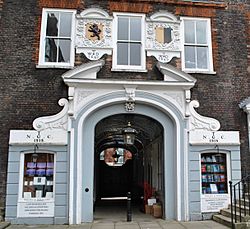John Pickering (soldier) facts for kids
Quick facts for kids
John Pickering
|
|
|---|---|

Lincoln's Inn, where Pickering trained as a lawyer
|
|
| Commissary-General, Army of the Eastern Association | |
| In office August 1643 – February 1644 |
|
| Personal details | |
| Born | baptised 3 December 1615 Titchmarsh, Northamptonshire |
| Died | 24 November 1645 (aged 29) Ottery St Mary |
| Cause of death | Typhus |
| Resting place | Lyme Regis castle |
| Alma mater | St Catharine's College, Cambridge Gray's Inn |
| Occupation | Lawyer, soldier, and religious radical |
| Military service | |
| Allegiance | Parliamentarian |
| Years of service | 1642 to 1645 |
| Rank | Colonel |
| Battles/wars |
|
Colonel John Pickering (born 1615, died 1645) was an important soldier from Northamptonshire. He fought for the Parliamentary army during the First English Civil War.
Like his older brother, Sir Gilbert Pickering, who was a close friend of Oliver Cromwell, John was a very religious person. He had strong beliefs that were sometimes seen as unusual for his time. He became a colonel in the New Model Army. Sadly, he died from a fever in 1645.
Early Life and Family
John Pickering was born in 1615 in Titchmarsh, Northamptonshire. He was the second son of Sir John Pickering and Susannah Dryden. His family were strong Puritans, meaning they had very strict religious beliefs.
His father, Sir John, was even arrested in 1627. This happened because he refused to pay special "loans" that King Charles I demanded. Sir John died in 1628, soon after being released from prison due to illness.
John's older brother, Sir Gilbert Pickering, became a MP for Northamptonshire. Gilbert was a very close friend and supporter of Oliver Cromwell. He held important positions in the government during Cromwell's time.
John also had a younger brother, Edward, and a sister, Mary. John Pickering never married and did not have any children.
Military Career and Key Battles
John Pickering went to Oundle School and then studied at St Catharine's College, Cambridge. This college was known for its Puritan teachings. After graduating in 1631, he began studying law in 1634.
Before the First English Civil War started in 1642, John worked for Parliament. He helped communicate with their allies in Scotland. He continued this important role into 1643.
In August 1643, John Pickering became the head of supplies for the Eastern Association army. Later, he joined a group of dragoons (soldiers who rode horses but fought on foot). In March 1644, he was hurt during a fight at Hillesden House, which was led by Cromwell.
Because of his bravery, he was made a colonel of a new infantry regiment. This regiment fought in major battles like Marston Moor in July and Second Newbury in October. After these battles, there were arguments about who was to blame for mistakes. Pickering supported Cromwell, which led to the removal of the Earl of Manchester from his command.
In April 1645, Sir Thomas Fairfax chose Pickering to lead one of the twelve infantry regiments in the new New Model Army. However, some members of the House of Lords initially disagreed with this choice. This was because Pickering and other officers chosen by Cromwell were religious Independents. Their strong, sometimes unusual, religious views worried the more moderate members of Parliament.
Pickering's regiment was stationed at Abingdon-on-Thames during the winter of 1644-1645. They lost many soldiers due to illness and fighting off a Royalist attack. New recruits joined the regiment, but some of them rebelled soon after Pickering took formal command. This was supposedly because they didn't like his preaching, but lack of pay might have also been a reason.
Despite this difficult start, Pickering's unit was known for being very religious and close to Cromwell. His officers included John Hewson and Daniel Axtell, who later played a role in the execution of King Charles I.
The regiment fought bravely at the Battle of Naseby. They then took part in the 1645 autumn campaign in South West England. This included capturing important Royalist strongholds like Sherborne Castle, Lacock Abbey, Bridgwater, Bristol, and Basing House.
During the siege of Exeter, John Pickering became very ill, probably with typhus. He died at Ottery St Mary on November 24, 1645. At his brother Gilbert's request, he was buried in Lyme Regis castle. John Hewson took over as the new colonel of the regiment.
Legacy
Today, "John Pickering's Regiment of Foote" is part of The Sealed Knot society. This is a group that performs historical reenactments of the English Civil War.
Sources

